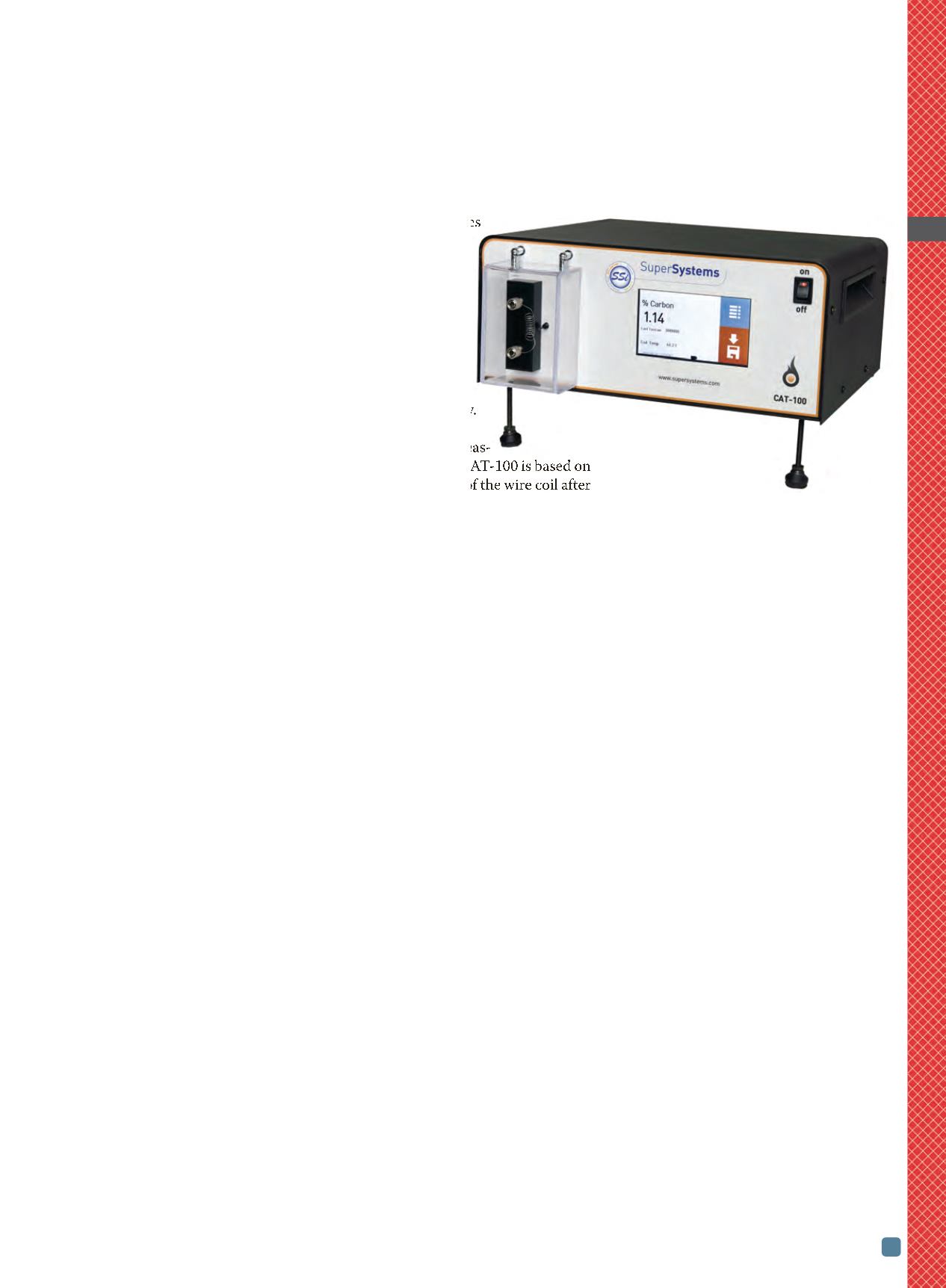

ADVANCED MATERIALS & PROCESSES •
JUNE 2014
45
APPLICATION NOTE
TOOL FOR ATMOSPHERIC CARBON
POTENTIAL ANALYSIS
A question frequently asked by heat
treaters is: “What is the actual carbon in
my furnace?” There are many tools for
continuous atmosphere monitoring, ver-
ification, and troubleshooting. They ad-
dress standard heat treating practices
and industry requirements, such as
AMS or CQI-9, to ensure continuous
control and periodic verification of the
furnace atmosphere used for the heat
treatment process.
Heat treaters regularly seek ways to pre-
vent and reduce rework and scrap loads
by implementing procedures and tools
to make sure the heat treating process
meets customer expectations and spec-
ifications. One process parameter re-
quirement is to ensure consistent
atmosphere carbon content. Measuring
carbon absorption into steel is com-
monly done to verify atmosphere consis-
tency. Super Systems’s CAT-100 instru-
ment is an atmosphere carbon potential
analyzer that provides a cost-effective
way to measure carbon using a wire coil
that functions in a way similar to using
shim stock.
Working principles
The CAT-100 measures carbon poten-
tial in a positive-pressure atmosphere.
The value is determined by measuring
specific properties of a steel wire coil in-
serted into an atmosphere made up of a
carbon-bearing gas for a predefined
time. The concept behind the instru-
ment is similar to that behind the com-
pany’s Shim Port method. Both use
metal pieces “soaked” in a carbon-con-
taining atmosphere as the basis for car-
bon analysis. Two important differences
between the instrument testing method
and the shim-stock method are the time
required to generate a carbon-potential
reading and the cost associated with the
measuring instruments.
CAT-100 is capable of providing on-site
carbon-potential measurement in less
than one hour, while the shim-stock
method requires specialized equipment
that many heat treaters do not have on
site. This requires
having an off-site
laboratory measure
the shim stock,
adding several days
to the process. Wire
coils are available
for use with the
CAT-100, and in-
strument calibra-
tion is relatively easy.
Carbon potential meas-
urement using the CAT-100 is based on
the carbon content of the wire coil after
soaking in the furnace, which is meas-
ured by analyzing changes in the metal-
lurgical properties of the coil. For
example, metallurgical changes caused
by carbon diffusing into the coil affect its
electrical resistance. Measurements are
made on the coil after removing it from
the furnace (at ambient temperature).
Measurement accuracy is dependent on
the coil temperature
.
Measured carbon potential is also de-
pendent on changes in surface metal
properties. The steel surface eventually
reaches equilibrium with a given gas
composition and furnace temperature.
Electrical resistance is directly propor-
tional to the amount of carbon present
in the fine-wire coil. Using the baseline
electrical resistance and carbon content
for the untreated wire, the addition
and/or depletion of carbon in the heat
treated wire can be accurately measured.
The instrument provides a direct read-
ing of percent carbon without the influ-
ence of gas composition.
The measurement can be influenced by
nitrogen absorption into the coil from
the furnace atmosphere. Because this
results in erroneous readings, the instru-
ment should not be used for carbonitrid-
ing processes.
Operating procedure
The instrument must be calibrated for
use with a specific wire coil. The reason
is that different lots of coils could have
different carbon content,
and the presoak carbon content of the
coil is crucial for accurate carbon poten-
tial measurement. Before the testing
process begins, the furnace atmosphere
must be verified as suitable for a coil
soak. Furnace temperature should be
generally uniform before the coil is in-
troduced to the atmosphere, and should
not change greatly during the soak. A
special insertion rod is used to place the
coil into the furnace atmosphere; it must
not be inserted within a furnace charge
or in a basket. The coil soaks in the at-
mosphere about 30 to 40 minutes de-
pending on the temperature, and is
removed after the soak is completed.
When the coil cools sufficiently
(quenching must not be used), it is at-
tached to testing posts on the instru-
ment and a carbon potential value is
displayed after about 30 seconds. Read-
ings can be stored in the instrument’s in-
ternal memory and can be downloaded
to a computer using included software.
Following proper procedures, carbon-
potential readings are accurate and re-
peatable. The CAT-100 is designed to
provide results within 0.03% of the car-
bon in an atmosphere containing 0.1 to
1.3% carbon (the effective testing range
of the instrument).
HTPRO
For more information:
Jim Oakes is vice
president, Business Development, Super
Systems Inc., 7205 Edington Dr., Cincinnati,
OH 45249, 513.772.0060, email:
joakes@ supersystems.com,
supersystems.com.
HTPRO
9
The CAT-100 provides accurate,
repeatable furnace atmosphere
carbon-potential readings.


















